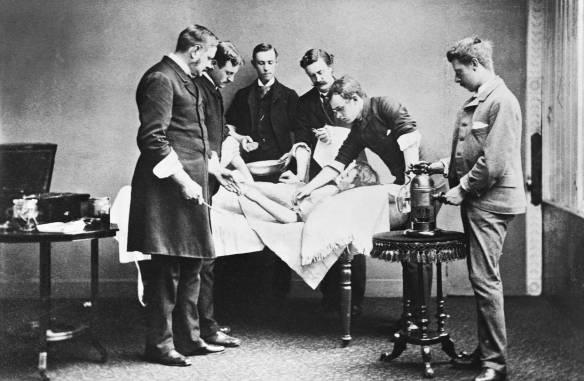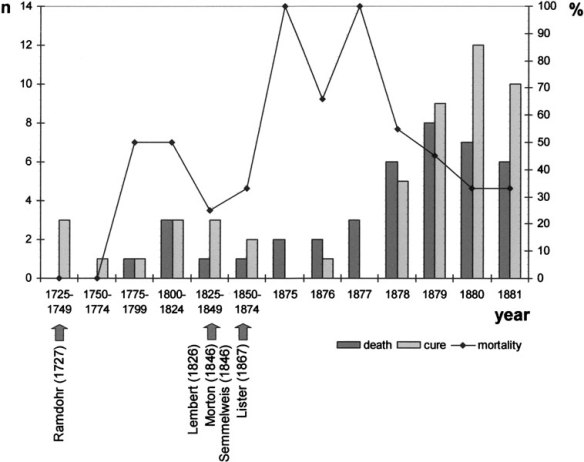The Senn retractor is a small, relatively delicate retractor that is used extensively in hand surgery, vascular surgery, plastic surgery and other procedures involving the skin and soft tissue. I hold this instrument most days I am in the OR and yesterday found myself wondering about this beautiful tool.
Nicholas Senn was an early adopter of Listerism and performed his operations under a fog of carbolic acid spray. He felt that smooth surfaces on surgical instruments were important to help prevent infection.1 That, plus the need for retraction in superficial wounds undoubtedly led to developing the Senn retractor.
 Surgery being performed under carbolic acid spray
Surgery being performed under carbolic acid spray
Nicolas Senn was born in 1844 and emigrated to the Fond du Lac, Wisconsin from St. Gaul, Switzerland in 1852. He graduated from Chicago Medical School in 1868, completed his residency at Cook County, started his academic career at the Medical College of Wisconsin, studied in Europe at the University of Munich and then returned as Professor at the University of Illinois. He served as president of the American Surgical Association in 1892, and was named president of the AMA in 19872, Dr.Senn was a military surgeon who served in the Spanish-American war and the Russo-Japanese war. Importantly, he founded the Association of Military Surgeons.2,3 He died in 1908 at the age of 64, five years before the American College of Surgeons was founded. There is little doubt that he would have been a founding member of the American College of Surgeons as he was the first Editor-In-Chief of SGO, which later became the Journal of the American College of Surgeons.4
In addition to his truly extraordinary resume, there are other facts and stories about Dr. Senn worth knowing. So, the next time you find yourself handing a student, resident, or assistant a Senn retractor you might want to share some of this history.
- Dr. Seen taught elementary school for a year and then studied with a local GP in Fond du Lac before entering medical school. 1
- There is a high school in Chicago named for him. He was known as an outstanding educator, so this is a particularly appropriate tribute.
- He was a collector of historical medical documents which resulted in a collection of over 10,000 volumes and 14,000 pamphlets and articles now stored in the John Crerar Library.2
- One of his most famous quotes is “The fate of the wounded rests with the one who applies the first dressing”2
- In 1904 he wrote a beautiful tribute to Father Damien who lived in the leper colony of Molokai which can be read here.
- He strongly supported early operation for appendicitis, which was not the practice of the time. “The principal object in writing this paper is to call the attention of the profession to the necessity of treating the primary disease of the appendix by radical measures before the advent of incurable complications, that is, before disease due to perforation has occurred.”5
- He was probably best known for his studies on intestinal perforation. To set the stage, Dr. Senn was a military surgeon in an era of transition. This was literally the time that it was finally “proved” that suturing a bowel perforation resulted in a better outcome. Senn used an animal model to instill hydrogen via the anus to see what kinds of pressure would result in bowel perforation.6 (The full text of Dr. Picher’s article, published in 1888, can be found here and is a fascinating read). He went beyond animal studies to show that this could be applied to humans by doing the same experiment on himself (short of the perforation we assume!). “Senn used a rubber balloon connected to a rubber tube inserted in his anus to pump 4 US gallons (15 L) of hydrogen gas into his intestinal tract. An assistant sealed the tube by squeezing the anus against it. The hydrogen was inserted by squeezing the balloon while monitoring the pressure on a manometer.” 2 This technique was subsequently used in soldiers who had been shot to determine if bullets had punctured the bowel.7
- Many of his experiments were carried out in the Nicholas Senn Building. He had this building serve as a place where students and medical professionals would gather to learn from one another. In the basement of the building he experimented with medical procedures that he would later carry out on patients.”8
- El-Sedfy A, Chamberlain RS. Surgeons and their tools: a history of surgical instruments and their innovators. Part III: the medical student’s best friend-retractors. Am Surg 2015;81:16-8.
- Nicholas Senn. Wikipedia. (Accessed May 5, 2018, at https://en.wikipedia.org/wiki/Nicholas_Senn.)
- Smith DC. Nicholas Senn and the origins of the Association of Military Surgeons of the United States. Mil Med 1999;164:243-6.
- . (Accessed May 5, 2018, at https://www.facs.org/about acs/archives/pasthighlights/sennclubdinner.)
- Senn N. A plea in favor of early laparotomy for catarrhal and ulcerative appendicitis, with the report of two cases. JAMA 1889;13:630-6.
- Pilcher JE. Senn on the Diagnosis of Gastro-Intestinal Perforation by the Rectal Insufflation of Hydrogen Gas. Ann Surg 1888;8:190-204.
- Senn N. The Modern Treatment of Gunshot Wounds in Miliatary Practice. JAMA 1898;31.
- Nicholas Senn Building. 2009. at http://genealogytrails.com/wis/milwaukee/nicholassennbuilding.html.)













